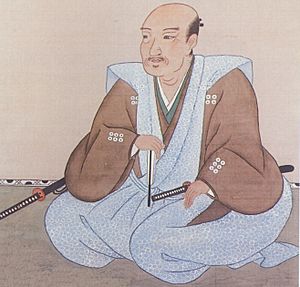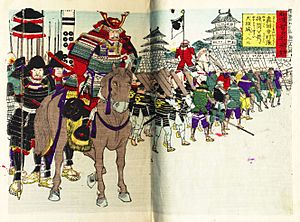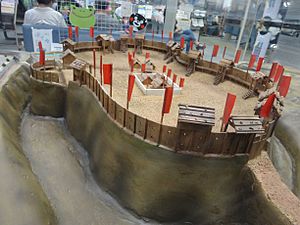Sanada Yukimura facts for kids
Quick facts for kids
Sanada Yukimura
|
|
|---|---|

An Edo period painting of Sanada Yukimura.
|
|
| Other name(s) | Sanada Nobushige Sanada Saemon-no-suke Ben-maru |
| Born | 1567 |
| Died | June 3, 1615 (aged 47–48) |
| Buried |
Zenmyosho-In, Ueda Domain
|
| Allegiance | |
| Unit | |
| Battles/wars | Siege of Oshi Siege of Ueda Siege of Osaka |
| Spouse(s) | Lady Hotta Lady Takanashi Chikurin-in |
| Children | Sanada Yukimasa (Daisuke) Katakura Morinobu (Daihachi) Sanada Yukichika (Gonzaemon) |
| Relations | Sanada Masayuki (father) Kanshō-in (mother) Sanada Nobuyuki (brother) Ōtani Yoshitsugu (father-in-law) Toyotomi Hideyoshi (adopted father-in-law) Komatsuhime (sister-in-law) |
Sanada Nobushige (真田 信繁, 1567 – June 3, 1615), also known as Sanada Yukimura (真田 幸村), was a famous Japanese samurai warrior. He lived during the Sengoku period, a time of many wars in Japan. Yukimura is best known as a brave general who defended Osaka Castle.
People called him "A Hero who may appear once in a hundred years" and "Crimson Demon of War." He was also known as "The Last Sengoku Hero." A famous warrior named Shimazu Tadatsune even called him the "Number one warrior in Japan" (日本一の兵).
Contents
Who Was Sanada Yukimura?
His Family and Early Life
Sanada Yukimura was the second son of Sanada Masayuki. His older brother was Sanada Nobuyuki. Yukimura married Chikurin-in, who was the daughter of Ōtani Yoshitsugu. She was also adopted by Toyotomi Hideyoshi, a powerful leader.
In 1575, a battle called the Battle of Nagashino happened. Yukimura's two uncles died in this battle. After this, his father, Masayuki, became the head of the Sanada family. Yukimura also took the Sanada name.
The Sanada Clan's Changing Alliances
Around 1582, two strong families, the Oda and Tokugawa, defeated the Takeda clan. The Sanada family first joined the Oda. But after a big event called the incident at Honnō-ji, they became independent again.
The Sanada clan then moved between different powerful daimyō (feudal lords). They joined the Uesugi clan, the Later Hōjō clan, and the Tokugawa clan at different times. Finally, the Sanada clan became loyal to Toyotomi Hideyoshi.
The Sekigahara Campaign: A Family Divided
Choosing Sides in a Big Battle
In 1600, a very important battle was about to happen: the Battle of Sekigahara. Before this, Tokugawa Ieyasu gathered many daimyōs to fight Uesugi Kagekatsu. The Sanada clan agreed to join Ieyasu.
However, Ishida Mitsunari decided to challenge Ieyasu. At this point, Yukimura and his father, Masayuki, chose to join Mitsunari's "Western Army." This meant they fought against Yukimura's older brother, Nobuyuki, who joined Ieyasu's "Eastern Army."
Historians have different ideas about why they split up. One idea is that Masayuki wanted to take a big risk. He thought if they joined the weaker side and won, the Sanada family would gain a lot of power. Another idea is that they planned it this way. They joined different sides so that no matter who won, the Sanada clan would survive.
The Siege of Ueda and Exile
The Sanada family went back to their home, Ueda Castle, and made it stronger. Tokugawa Hidetada marched a large army of 40,000 men to attack Ueda. But the Sanada, with only 2,000 men, fought them off.
Hidetada's army could not take the castle quickly. He eventually gave up and moved to join the main Tokugawa army. But he arrived too late for the main Battle of Sekigahara. After the big battle, Yukimura's father lost his land. Both Yukimura and his father were sent away to Mount Kōya. Ueda Castle was then given to Yukimura's brother, Nobuyuki.
The Osaka Campaign: Yukimura's Last Stand
The Winter Siege of Osaka Castle

The Siege of Osaka Castle was a series of battles between the Tokugawa family and the Toyotomi family. It happened from 1614 to 1615 and ended the Toyotomi family's power. The first part was the Winter Campaign, which started in November 1614.
On December 4, 1614, the siege of Osaka Castle began. Yukimura built a special small fort called Sanada-maru at one corner of Osaka Castle. This fort was a strong earth wall defended by 7,000 men under Yukimura's command.
From the Sanada-maru, Yukimura's soldiers, including 6,000 men with arquebuses (early guns), fought against about 30,000 Tokugawa soldiers. The Tokugawa forces were pushed back many times. Yukimura's troops even broke through the enemy lines three times.
Ieyasu then used artillery, including 17 cannons from Europe. He also used sappers to dig under the castle walls. But the fort was too strong, and the Tokugawa army lost many soldiers. Ieyasu decided to make peace with Toyotomi Hideyori. He asked that the outer moat (a ditch around the castle) be destroyed. But when his people entered the castle, they destroyed both the outer and inner moats.
The Summer Siege and Yukimura's Death
The fighting started again in the summer of 1615. On June 3, 1615, at the Battle of Dōmyōji, Sanada Yukimura led the Osaka Army's right side. He fought against the forces of Date Masamune. After this fight, Yukimura decided to go back to Osaka Castle.
The next day, June 3, 1615, at the Battle of Tennōji, Yukimura found a huge Tokugawa army of about 150,000 soldiers getting ready to attack the castle. The Toyotomi forces, with about 54,000 to 60,000 troops, launched a final attack.
Yukimura's troops charged bravely. They fought with great courage. Yukimura saw a chance to break through the middle of the Tokugawa army. He hoped that if he could keep them busy, Hideyori would come out of the castle and lead a big charge. Yukimura sent his son, Sanada Daisuke, to tell Hideyori to attack. But Hideyori was too slow.
As the battle continued, the tired Yukimura sat down. Legend says his last words were, "Who dares to take my head?" A Tokugawa samurai named Nishio Nizaemon recognized Yukimura. Yukimura, too weak to fight, took off his helmet. Moments later, he died.
The place where Sanada Yukimura was killed is at Yasui Shrine in Osaka. His grave is in Zenmyosho-In in Ueda.
Sanada Yukimura's Family
Yukimura had a large family. His father was Sanada Masayuki, and his mother was Kanshō-in. He had several brothers and sisters.
Yukimura's Children
- Sue/Kiku: His oldest daughter.
- Ichi: His second daughter.
- Sanada Daisuke: His oldest son with Chikurin-in. He fought with his father at Osaka Castle and died there.
- Oume: His daughter with Chikurin-in. She married Katakura Shigenaga. Thanks to Oume, many Sanada family members found safety with the Katakura clan.
- Naho: His daughter with Ryūsei-in.
- Akuri: His daughter with Chikurin-in. She was adopted by a Tokugawa supporter after Osaka Castle fell.
- Oshobu: His daughter with Chikurin-in. She was adopted by Katakura Shigenaga.
- Okane: His daughter with Chikurin-in. She married Ishikawa Sadakiyo.
- Sanada Daihachi: His second son with Chikurin-in. He was adopted by Katakura Shigenaga and became Katakura Morinobu.
- Miyoshi Yukinobu: His son with Ryūsei-in. He was born after his father died.
- Sanada Yukichika: Another son, born after his father's death. He appears in folk tales.
Legends and Popular Stories
Interestingly, in old historical records, Yukimura was never called "Yukimura." His real name was "Nobushige." The name "Yukimura" became popular much later in stories and plays.
One famous legend says that Yukimura had ten special heroes, like ninjas, who helped him at Osaka Castle. They were called the Sanada Ten Braves.
Another myth says that Yukimura actually killed Ieyasu. But the story goes that Ieyasu was replaced by a kagemusha (a look-alike). This myth shows how much people respected Yukimura's skills as a military leader.
There's also a story that Ieyasu offered Yukimura a lot of land and money if he left the Toyotomi side. Yukimura just laughed and put the offer on a wall for everyone in the castle to see.
In Popular Culture
Sanada Yukimura is a very popular figure in Japan. He appears in many modern stories, video games, and TV shows.
- Sanada Taiheiki: A Japanese TV drama from 1985.
- Sanada Maru: A Japanese TV drama from 2016.
- Samurai Warriors: Spirit of Sanada: A video game about the Sanada clan.
Images for kids
See also
 In Spanish: Sanada Yukimura para niños
In Spanish: Sanada Yukimura para niños





